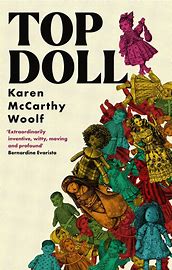Top Doll
Karen McCarthy Woolf
(Dialogue Books, 2024); hbk, £20
Infinity is an episode long
and troubling to decipher [,]
Dolly
How might a writer work their way into writing an expansive historical telling of the vastness of United States, uncovering a multitude of people, of oppressions, victories, defeats and ongoing struggles? Recalling the cliché, ‘When America sneezes, the world catches a cold’, of course the scale becomes world-wide. Further, the tale should not become nigh abstract in its universalism. It requires individual interests, so the reader will care for the characters. No small task.
Annie Proulx attempted it in the ambitious Barkskins (2016) (and less expansively in Accordion Crimes (1996)). It met a mixed reception. Many have tried; reviewing such books is challenge enough! How did Karen McCarthy Woolf fare?
For of course a doll’s Heart is inextricably linked to that of its Human. It is a vacuum which
transcends matter, a mirror image, almost exact, yet reversed.The General
Then, we have the cast-around, abused rag doll Miss Ting, and Lady Mamiko, who speaks with increasing certainty in a westernised understanding of haiku. Perhaps we sight certain difficulties here. In other hands we might well be in the realms of dangerous stereotyping. But, of course, browsing Top Doll that straightforwardly would be to miss the reflective brilliance of McCarthy Woolf’s achievement.
cos h’everybody know dem must follow flesh-fashion. Is the way a di doll world.
Miss Ting
To read Top Doll is to enter a room with mirrors on opposite walls, endlessly reflecting the reader and one another. The poet holds a glass to the original, both real and supposed, but also to the copies, the stereotypes. You will expect the examination of the slave trade, of the treatment of First Peoples. The Jim Crow laws are there. And yes, you will find reference to ‘those mawkish minstrels’. The persecution of homosexuals, the straitened circumstances of women, the rise in eating disorders. Italian Barbie is a Mafiosa, the Brazilian one hits Carnivale, and Nigerian Barbie covers arms dealing and Rolexes. Swiss Barbie and finishing schools, and yes the English and the Windsors. Meanwhile, in clipped couplets Moscow Barbie goes undercover with
Tatiana was most popular dinner date in all
Kremlin She is driving Mercedes while First Lady sit in
Lada! It is not a matter of debate if Tatiana has lover in
Moldova bendy as acrobat in Moscow State Circus
Niet!A relish of full-on stereotyping. As a mixed-race, non-American woman, with lived experience of the USA, McCarthy Woolf’s perspective glints.
Every doll’s idiolect is precise, expressed in words, in the forms employed, and even in the typographical spacing.
I am utterly bisque.
Dolly
There’s something in how the dolls’ (and the ‘Soft-Fleshes’) materials and constructions are conveyed, which feels near pathetic fallacy. Raymond Antrobus describes ‘an immersive, playful […] time-travelling story…’ and that playfulness is joyous. Yes, tragedy abounds, but Top Doll is also a blast, being outrageously, subversively, laugh-aloud funny. Throughout, the mirror is offered, and privilege is called out.
What Karen McCarthy Woolf delivers, however, exceeds her remarkable examination of the experience, problems and vulnerabilities of categorisation. In her use of what is made in our image, Top Doll sits beside Kazuo Ishiguro’s Klara and the Sun, and differently, speaks to what it is to be human.
Beth McDonough


Leave a Reply